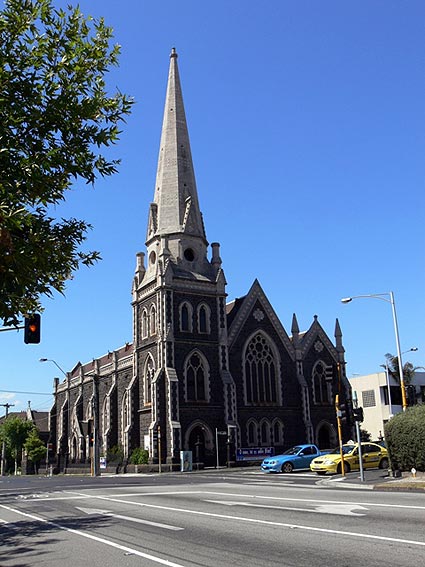
St Kilda Presbyterian Church – exterior
[photograph by Trevor Bunning (October 2008)]
Historical and Technical Documentation by John Maidment
© OHTA, 2008 (last updated November 2021)

St Kilda Presbyterian Church – exterior
[photograph by Trevor Bunning (October 2008)]
Historical and Technical Documentation by John Maidment
© OHTA, 2008 (last updated November 2021)
An earlier church, placed on the crest of a hill, was opened on Sunday 11 December 1860.1 The present church is constructed in bluestone with freestone dressings and designed in the Decorated Gothic style; the foundation stone was laid by the Governor of Victoria Sir Henry Brougham Loch on 27 January 1885 and the building opened on 30 May 1886.2 Its size is indicative of the affluent nature of the surrounding residential area at the time of construction. The architects were Wilson & Beswicke, a partnership founded in 1881 by Ralph Wilson and John Beswicke, who were also responsible for the Malvern Town Hall. The building is very much in the idiom of the former phase of the partnership when known as Crouch & Wilson, particularly in the placement of the tower and spire to the left of the main façade (for example Pilgrim Uniting Church, Launceston, Tasmania).
The exterior is dominated by an imposing tower and spire, rising to 142 feet, once a landmark for mariners, which incorporates corner pinnacles (now missing their conical caps) and circular clock openings placed beneath Gothic gables. The spacious hall-church interior, with lofty aisles, broad nave and raked floor, focusses upon a large apse whose ceiling (like The Scots’ Church in the city) was once embellished with stars. At the rear there are twin porches and a narthex with a staircase to the rear gallery where the choir and an earlier organ were initially housed. The aisles are divided from the nave by tall cast iron columns with floriated capitals; this material is also used for the balustrading of the gallery and pulpit as well as the external fence and gates.
The building is lit by large Gothic windows with geometric tracery. They incorporate glass by the following craftsmen: in the apse, Ferguson & Urie, depicting Faith, Hope and Charity; on the west side, at the rear, Ernest R. Suffling, Edgware Road, London (signed) c.1892; and two windows to the front, the first by Mathieson & Gibson, of Melbourne (signed) inserted in the 1930s and a second, to the left, probably by Brooks, Robinson, inserted in 1949. To the east there is a splendid window by the renowned artist Napier Waller, dating from 1950, of interest for its stylised faces and leaf patterns. The remaining windows have quarry glass with coloured borders.3
The woodwork in the church is of particular note. The magnificent pulpit, in polished kauri with blackwood detailing, incorporates intricate relief panels, splendidly carved by John Kendrick Blogg, depicting the burning bush, wheat ears, grapes and St John’s lilies. In the narthex there is a First World War memorial finely carved in Tasmanian blackwood.4 The cedar pews incorporate ends of unusual design with turned columns and enamelled location plaques; the central section is divided. The ceiling is of tongue and groove boards laid diagonally.
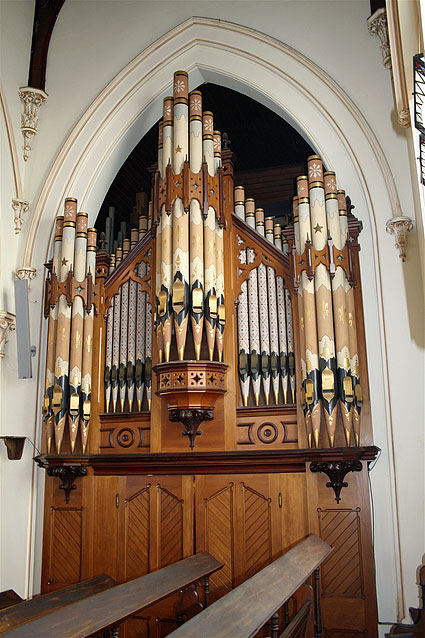
St Kilda Presbyterian Church: the 1892 Fincham & Hobday organ
[photograph by Trevor Bunning (October 2008)]
The first pipe organ was opened on 4 May 1880 and was a two-manual instrument of 17 speaking stops (16 ranks) built by William Anderson. This was sold in 1892 to St Alban's Anglican Church, Armadale where it still survives, although in an altered state. The initial scheme for the present organ was submitted to the church by Fincham & Hobday on 28 July 1890 and this was amended on 23 February 1891.5 Alfred Fuller also tendered for the work. The instrument cost £1030 and was opened on 29 April 1892.6 It was a three-manual organ of 27 speaking stops, detached drawstop console and tubular-pneumatic action – this also extended to the swell shutters (with individual pneumatic motors attached to each shutter, this preceded later developments by Wurlitzer and Christie – Fincham & Hobday also used this system at St Kilda Town Hall and St Joseph’s, Warrnambool, where it survives.
The firm was working at the time at peak capacity and also completed in the same year new three-manual instruments for St Kilda Town Hall and St Joseph’s Catholic Church, Warrnambool and rebuilt the organ at Wesley Church, Melbourne. The Great Posaune 8 was initially prepared for and later added (in black metal) in the 1920s. In 1907 the organ was restored and cleaned and electric blowing was added (the original hydraulic plant may not have worked efficiently owing to the placement of the church at the top of St Kilda hill).7
In 1955 the tubular-pneumatic action was electrified, single-rise wind regulators installed in place of the original double-rise reservoir, the Choir Organ enclosed in a swell box and a new drawstop console during a rebuild by George Fincham & Sons Pty Ltd. The original tonal scheme remained unaltered, but four additional pedal stops were provided through extension of original material (Principal 8, Bass Flute 8, Octave Quint 5-1/3 and Fifteenth 4).8
The instrument retains all of its original pipework, slider windchests and the attractive three-tower case in polished kauri and blackwood, with intricately carved corbels, containing attractively stencilled zinc pipes, those in the centre of each tower having ogee mouths. The casework was used as a model for the 1902 Geo. Fincham & Son organ at Chalmers Presbyterian Church, Launceston (this case is now at St Silas’ Anglican Church, Albert Park) while Arthur Hobday used a photograph of the St Kilda organ to promote his work in New Zealand; it also featured in the Geo. Fincham & Son catalogue of c.1900. The pipework is likely to have been voiced by Fincham’s partner Arthur Hobday and is a distinguished example of his work.
The 1892 specification follows:
| GREAT Double Open Diapason Open Diapason Horn Diapason Claribel Principal Harmonic Flute Quint 8va Fifteenth Posaune Swell to Great Sub Swell to Great Swell to Great Super SWELL Bourdon Open Diapason Gedact Gamba Celeste Octave Super Octave [Sesquialtera] Mixture Cornopean Oboe 8 CHOIR Hohl Flöte Gamba Dulciana Rohr Flöte Piccolo Clarionet Swell to Choir PEDAL [Grand] Open Diapason Bourdon Pedal Octave Great to Pedal Swell to Pedal Choir to Pedal |
16 8 8 8 4 4 3 2 8 16 8 8 8 8 4 2 III 8 8 8 8 8 4 2 8 16 16 |
1-12 stopped wood slotted (shown in initial scheme as Mixture 3 ranks) black metal 1920s gvd bass to Gedact (Keraulophon in original scheme) TC (not present in original scheme) 17.19.22 gvd bass to Hohl Flöte gvd bass to Hohl Flöte TC |
Compass: 56/30
3 thumb pistons to Great
3 thumb pistons to Swell
Lever swell pedal (pneumatic)
Tubular-pneumatic action
Detached drawstop console
Spotted metal fluework above 4ft, reeds in spotted metal to 8ft9
The current specification reads:
| GREAT Double Diapason Open Diapason Horn Diapason Claribel Principal Harmonic Flute Twelfth Fifteenth Posaune Swell to Great Sub Swell to Great Swell to Great Super Choir to Great |
16 8 8 8 4 4 2-2/3 2 8 |
1-12 stopped wood added 1920s (black metal) |
|
| SWELL Bourdon Open Diapason Gedact Gamba Voix Celeste Octave Fifteenth Mixture 17.19.22 Cornopean Oboe Tremulant Swell Sub Swell Super |
16 8 8 8 8 4 2 3 ranks 8 8 |
gvd.bass TC |
|
| CHOIR (enclosed) Hohl Flute Gamba Dulciana Rohr Flute Piccolo Clarinet Tremulant Swell to Choir |
8 8 8 4 2 8 |
gvd.bass |
|
| PEDAL Open Diapason Bourdon Principal Bass Flute Octave Quint Fifteenth Great to Pedal Swell to Pedal Choir to Pedal |
16 16 8 8 5-1/3 4 |
A B A B B A |
Compass: 61/30
Detached console with drawstops for speaking stops and stopkeys for couplers
Electro-pneumatic action10
1 The Argus, 17 December 1860, p.5
2 Ibid., 19 May 1885, p.12
3 Information provided by Geoff Down
4 Marjorie Morgan, Legacy in Sculptured Wood: an appreciation of the work of John Kendrick Blogg, 1851-1926. Burwood, Vic.: Marjorie Morgan Publications, 1993, p.22
5 Correspondence from Fincham & Hobday (housed at State Library of Victoria) notes courtesy of organist Tim Baker
6 Ibid., 7/344, 14/247, courtesy of E.N. Matthews, Colonial Organs and Organbuilders. Carlton: Melbourne University Press, 1969, pp.149-150
7 Matthews, ibid.
8 Notes by John Maidment
9 1892 specification from Dr D.W. Rankin, noted before 1955
10 1955 specification from John Maidment, noted 1966
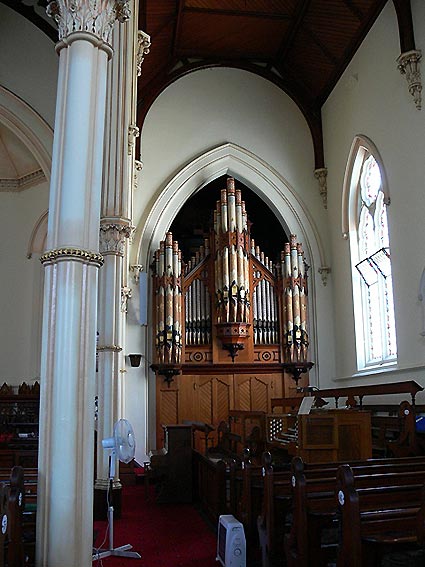
St Kilda Presbyterian Church: case and console
[photograph by Trevor Bunning (October 2008)]
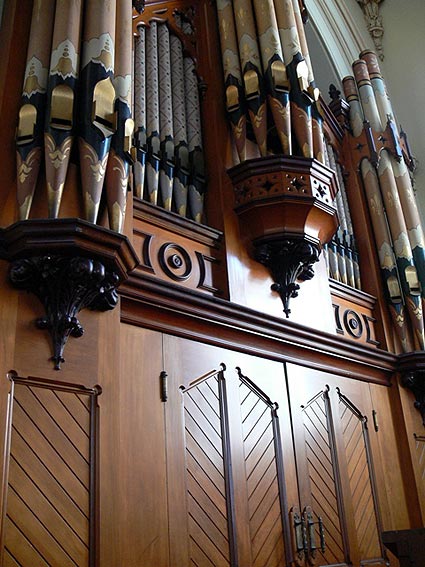
St Kilda Presbyterian Church: case detail
[photograph by Trevor Bunning (October 2008)]
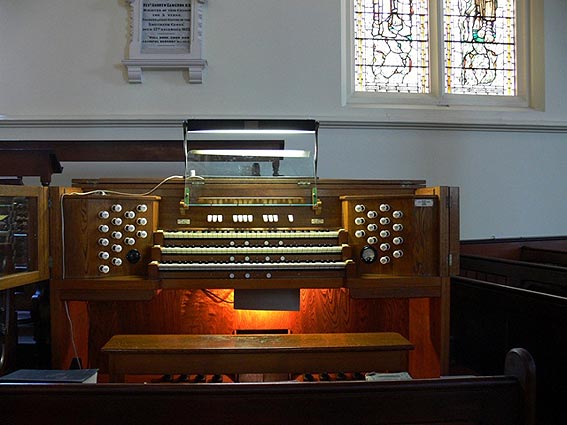
St Kilda Presbyterian Church: 1955 console
[photograph by Trevor Bunning (October 2008)]
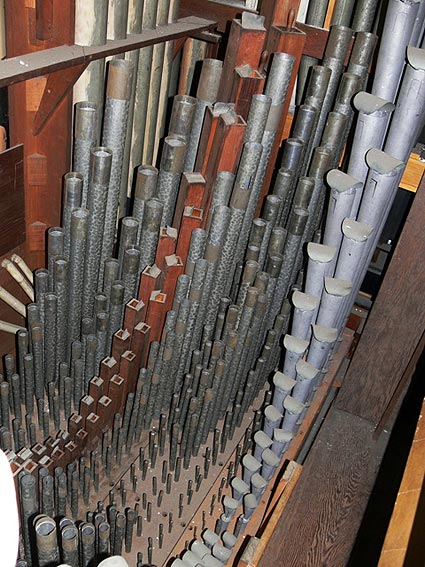
St Kilda Presbyterian Church: Great Organ pipework
[photograph by John Maidment (January 2008)]
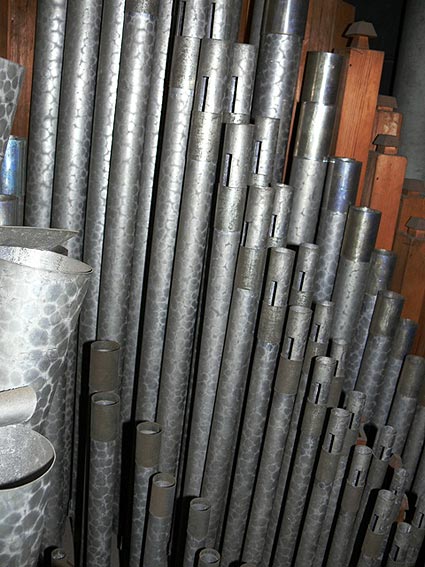
St Kilda Presbyterian Church: Swell Organ pipework
[photograph by John Maidment (January 2008)]
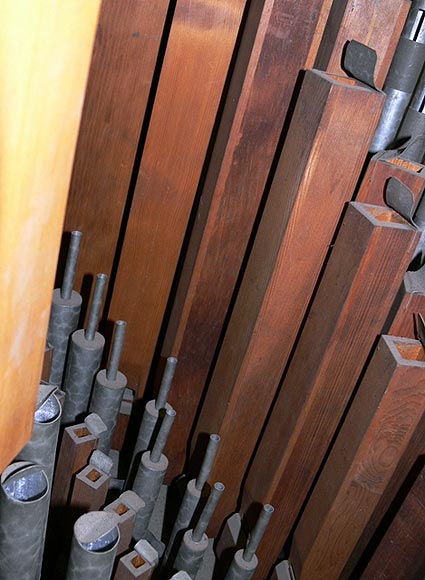
St Kilda Presbyterian Church: Choir Organ pipework
[photograph by John Maidment (January 2008)]
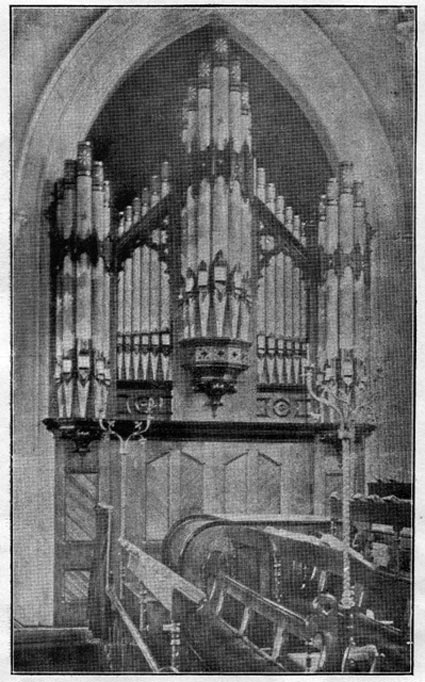
St Kilda Presbyterian Church: organ from the c.1900 Geo.Fincham & Son catalogue showing the placement of the original 1892 console
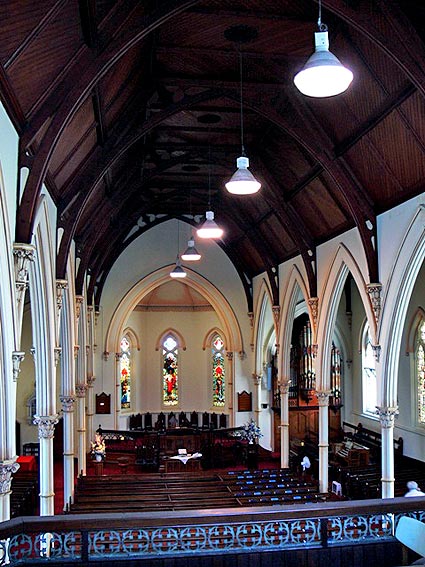
St Kilda Presbyterian Church: interior from the rear gallery
[photograph by Trevor Bunning (October 2008)]
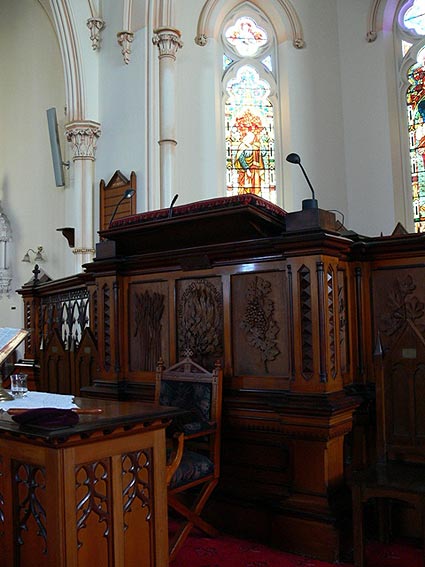
St Kilda Presbyterian Church: pulpit carved by J.K. Blogg
[photograph by Trevor Bunning (October 2008)]
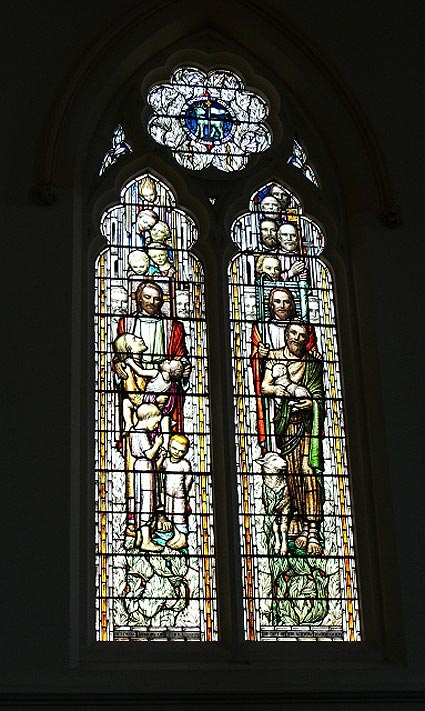
St Kilda Presbyterian Church: Napier Waller window
[photograph by John Maidment (January 2008)]
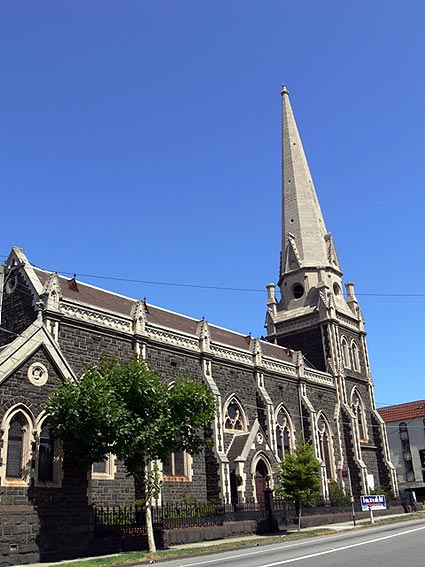
St Kilda Presbyterian Church: exterior from north-west
[photograph by Trevor Bunning (October 2008)]